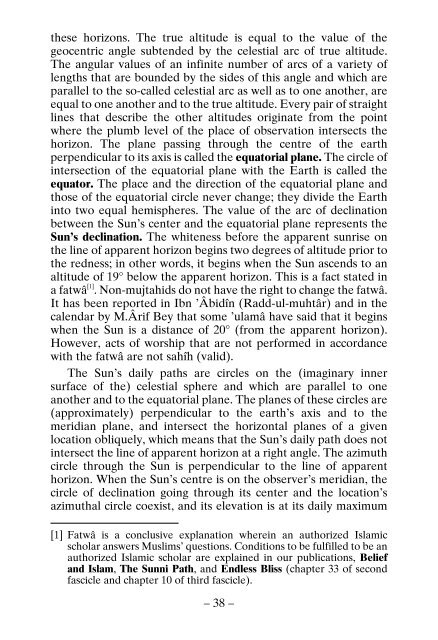O Son !
THE BOOK ‘O SON’ Al-hamdu lillâhi Rabbil ’âlamîn. Wa-s-salâtu wa-s-salâmu ’alâ Rasûlinâ Muhammadin wa Âlihi wa Sahbihi ajma’în. 1– O son! Collecting from books written by the scholars of the Hanafî Madhhab three hundred and sixty hadîth-i-sherîfs and forty-four khabars and also the seven essentials and the five rukns and the seven wâjibs and the fourteen sunnats and the twenty-five mustahabs and the fourteen mufsids of namâz, I have explained them for you. Adapt your acts and deeds to these teachings so that you attain fayz and nejât (salvation)! 2– Also for your information, I have collected a thousand and ninety âdâb (adabs) for you and for other young Muslims like you. If you adapt your actions and acts of worship to these teachings, they will be sufficient for you. If you laze, disobey Allâhu ta’âlâ and cease from these practices and manners, you will be afflicted with slavery and disgrace in the world and subjected to torment in the world to come. If you live up to them and advise your Muslim brothers to do the same, it will be useful for you. They will say blessings over you. And Haqq ta’âlâ will accept their invocations. For, a slave will be pardoned on account of another slave’s invocations for them.
THE BOOK ‘O SON’
Al-hamdu lillâhi Rabbil ’âlamîn. Wa-s-salâtu wa-s-salâmu ’alâ
Rasûlinâ Muhammadin wa Âlihi wa Sahbihi ajma’în.
1– O son! Collecting from books written by the scholars of the
Hanafî Madhhab three hundred and sixty hadîth-i-sherîfs and
forty-four khabars and also the seven essentials and the five rukns
and the seven wâjibs and the fourteen sunnats and the twenty-five
mustahabs and the fourteen mufsids of namâz, I have explained
them for you. Adapt your acts and deeds to these teachings so that
you attain fayz and nejât (salvation)!
2– Also for your information, I have collected a thousand and
ninety âdâb (adabs) for you and for other young Muslims like you.
If you adapt your actions and acts of worship to these teachings,
they will be sufficient for you. If you laze, disobey Allâhu ta’âlâ
and cease from these practices and manners, you will be afflicted
with slavery and disgrace in the world and subjected to torment in
the world to come.
If you live up to them and advise your Muslim brothers to do
the same, it will be useful for you. They will say blessings over you.
And Haqq ta’âlâ will accept their invocations. For, a slave will be
pardoned on account of another slave’s invocations for them.
You also want an ePaper? Increase the reach of your titles
YUMPU automatically turns print PDFs into web optimized ePapers that Google loves.
these horizons. The true altitude is equal to the value of the<br />
geocentric angle subtended by the celestial arc of true altitude.<br />
The angular values of an infinite number of arcs of a variety of<br />
lengths that are bounded by the sides of this angle and which are<br />
parallel to the so-called celestial arc as well as to one another, are<br />
equal to one another and to the true altitude. Every pair of straight<br />
lines that describe the other altitudes originate from the point<br />
where the plumb level of the place of observation intersects the<br />
horizon. The plane passing through the centre of the earth<br />
perpendicular to its axis is called the equatorial plane. The circle of<br />
intersection of the equatorial plane with the Earth is called the<br />
equator. The place and the direction of the equatorial plane and<br />
those of the equatorial circle never change; they divide the Earth<br />
into two equal hemispheres. The value of the arc of declination<br />
between the Sun’s center and the equatorial plane represents the<br />
Sun’s declination. The whiteness before the apparent sunrise on<br />
the line of apparent horizon begins two degrees of altitude prior to<br />
the redness; in other words, it begins when the Sun ascends to an<br />
altitude of 19° below the apparent horizon. This is a fact stated in<br />
a fatwâ [1] . Non-mujtahids do not have the right to change the fatwâ.<br />
It has been reported in Ibn ’Âbidîn (Radd-ul-muhtâr) and in the<br />
calendar by M.Ârif Bey that some ’ulamâ have said that it begins<br />
when the Sun is a distance of 20° (from the apparent horizon).<br />
However, acts of worship that are not performed in accordance<br />
with the fatwâ are not sahîh (valid).<br />
The Sun’s daily paths are circles on the (imaginary inner<br />
surface of the) celestial sphere and which are parallel to one<br />
another and to the equatorial plane. The planes of these circles are<br />
(approximately) perpendicular to the earth’s axis and to the<br />
meridian plane, and intersect the horizontal planes of a given<br />
location obliquely, which means that the Sun’s daily path does not<br />
intersect the line of apparent horizon at a right angle. The azimuth<br />
circle through the Sun is perpendicular to the line of apparent<br />
horizon. When the Sun’s centre is on the observer’s meridian, the<br />
circle of declination going through its center and the location’s<br />
azimuthal circle coexist, and its elevation is at its daily maximum<br />
[1] Fatwâ is a conclusive explanation wherein an authorized Islamic<br />
scholar answers Muslims’ questions. Conditions to be fulfilled to be an<br />
authorized Islamic scholar are explained in our publications, Belief<br />
and Islam, The Sunni Path, and Endless Bliss (chapter 33 of second<br />
fascicle and chapter 10 of third fascicle).<br />
– 38 –

















